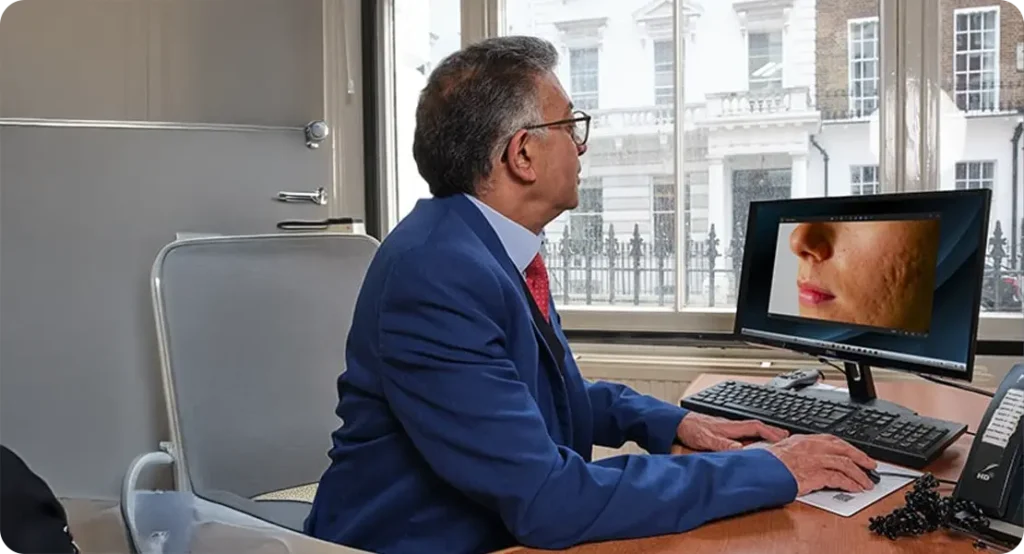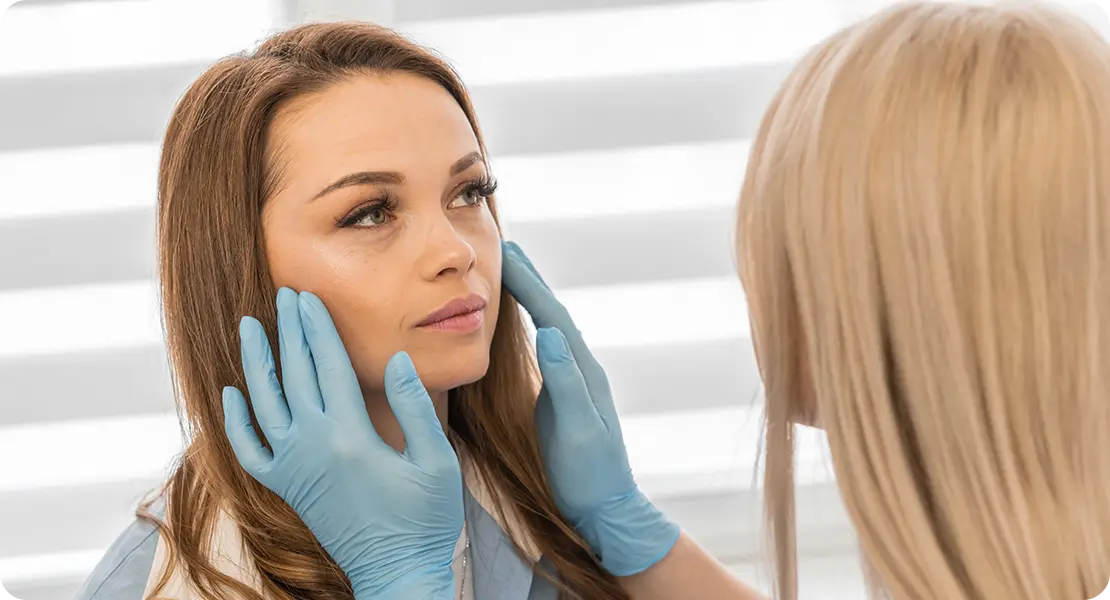So, you’ve been staring at your skin in the mirror, wondering whether that new spot, stubborn acne, or patch of dry skin means it’s time to get professional help. But here’s where it gets confusing: do you book an appointment with a dermatologist or an aesthetician? What even is the difference?
If you’re scratching your head (hopefully not due to a skin issue!), don’t worry. This guide is here to break down the key differences between dermatologists and aestheticians, so you can make the right choice for your skin needs.
Let’s Start with the Basics: Who Are They?
Dermatologists are medically trained doctors who specialise in skin, hair, and nail conditions. Think of them as the GPs of the skin world—except with years of additional training in dermatology after medical school. They’re the ones to go to if you’re dealing with anything complex, chronic, or potentially serious.
After completing a full medical degree, dermatologists enter a competitive and rigorous specialist training programme that typically spans several years. During this time, they not only build a deep understanding of how skin conditions develop, but they also learn to recognise rare disorders, perform surgical procedures, and manage conditions that may be linked to internal health issues. Their training allows them to diagnose diseases that may present first through skin symptoms, such as autoimmune disorders or skin cancers.
Dermatologists often split their time between hospital clinics and private practices, with some focusing more on medical dermatology, while others take on surgical or cosmetic cases. Their scope is incredibly broad, ranging from treating infants with birthmarks to helping older adults manage skin cancer. Because they’re regulated under medical councils, patients can trust that their decisions are backed by solid scientific research and clinical evidence.
If you’re experiencing something out of the ordinary—like persistent itching, unexplained rashes, or changing moles—a dermatologist has the training to investigate further. They can order tests, conduct biopsies, and develop treatment plans that might include medication, lifestyle changes, or surgical intervention. In short, they’re the go-to professionals for skin problems that go beyond the surface.
Aestheticians, on the other hand, are trained in skincare treatments that are focused more on cosmetic improvements and maintenance. Their work is non-medical, but that doesn’t mean it’s not valuable. They can give you that healthy glow, help with breakouts, and guide you in choosing the right skincare routine.
Aestheticians often begin their careers by completing a professional diploma or certification in beauty therapy, which includes both theory and practical training. Their education covers anatomy of the skin, product chemistry, and techniques for performing treatments like facials, exfoliation, waxing, and newer technologies like LED light therapy and dermaplaning. While their training is shorter than that of a dermatologist, it is still comprehensive and highly hands-on.

What sets aestheticians apart is their ability to customise treatments based on your skin’s current state, rather than just a diagnosis. They observe texture, hydration levels, and tone, and suggest therapies or products that can enhance your skin’s appearance over time. For those who want a consistent skincare routine or regular maintenance, aestheticians offer continuity and personalisation that can be incredibly beneficial.
Aesthetic work also leans heavily into relaxation and wellbeing. Treatments are often designed not only to improve skin but to give you a break from the daily grind. Regular appointments with an aesthetician can help you stay on top of your skincare goals, catch problems early, and feel more confident in your own skin—without the need for medical intervention.
Training: Medical Degree vs. Specialist Certificate
One of the most significant differences between dermatologists and aestheticians lies in the depth and length of their training. Dermatologists are fully qualified medical doctors who have completed years of academic and clinical education. Their journey begins with a five to six-year medical degree, followed by a period of supervised work as a junior doctor before moving into a highly competitive specialist training programme in dermatology.
This specialist phase can last several more years, during which dermatologists gain in-depth knowledge of diseases affecting the skin, hair, and nails. They learn how to diagnose rare and complex conditions, manage long-term skin disorders, and perform minor surgical procedures. Their training also includes experience in interpreting lab results, recognising signs of internal illness that manifest on the skin, and understanding how different medications impact the body.
Aestheticians, in contrast, typically train through vocational or diploma-based programmes, which are shorter and focused on cosmetic skincare. These courses usually last between a few months to a couple of years, depending on the level of qualification and whether any advanced modules are included. Their education covers subjects like skin anatomy, product ingredients, and techniques for non-invasive treatments such as facials, peels, and exfoliation.
As part of their training, aestheticians gain hands-on experience in delivering treatments that enhance skin appearance and support skin health on a surface level. While they do not diagnose or treat medical conditions, they are highly skilled in identifying skin types, choosing appropriate treatments, and advising clients on daily skincare routines. Their focus is firmly on appearance, maintenance, and prevention.
So, when deciding who to see, consider the nature of your skin concern. If it’s something medical—like a persistent rash, ongoing acne, or a mole that’s changed in shape—it’s essential to see a dermatologist. But if your goal is to improve texture, brightness, or hydration through professional skincare, then an aesthetician could be the perfect starting point.
Conditions vs. Cosmetic Concerns
Here’s a simple way to separate the two: dermatologists treat conditions, while aestheticians handle cosmetic concerns.
Say you’ve got cystic acne that’s painful, inflamed, and just won’t go away. That’s a medical condition, and it might need prescription treatments or even hormone management. A dermatologist can help with all of that.
But if your skin is generally healthy and you’re looking for regular facials, help with hydration, or to reduce fine lines, an aesthetician can be a great support. They’re trained to spot when something looks wrong too, and many will refer you to a dermatologist if they spot something suspicious.
Prescription vs. Products
Another clear difference is in what they can offer you in terms of treatment. Dermatologists can prescribe medications—both topical and oral—perform biopsies, and even offer minor surgical procedures. If your skin concern might require a prescription, such as antibiotics for acne or steroids for eczema, you’ll need to go the medical route.
Aestheticians can’t prescribe medication, but they often have access to professional-grade skincare products and machines that you wouldn’t find at your local shop. They can guide you on product use, carry out peels, or use technology like ultrasound or radiofrequency to rejuvenate your skin.

It’s worth noting that in recent years, there’s been a lot of crossover. Some clinics have dermatologists and aestheticians working side by side, offering a hybrid approach—medical when needed, cosmetic when wanted.
Who Should You See First?
This really depends on your concern. Here’s a guide:
• If you have a rash, persistent redness, or a spot that’s changing shape or colour, go straight to a dermatologist.
Skin changes that appear suddenly or persist without clear cause should never be ignored. Rashes, for instance, can be a sign of anything from allergic reactions to autoimmune disorders, and without proper evaluation, they can worsen or spread. A dermatologist has the training to look beyond the surface, using their clinical knowledge to identify potential underlying causes and suggest the right course of action, which might involve medication, patch testing, or further investigation.
When it comes to redness that won’t go away—whether it’s around the nose, cheeks, or forehead—it could be linked to conditions like rosacea, seborrhoeic dermatitis, or even lupus. These aren’t things that can be treated with over-the-counter products alone, and misdiagnosing the issue could actually make it worse. Dermatologists are equipped to distinguish between similar-looking conditions and provide a tailored treatment plan that targets the root of the issue.
Moles or spots that change in shape, size, or colour are particularly concerning and should be reviewed urgently. These changes can sometimes signal skin cancer, and early detection is key to a successful outcome. Dermatologists can assess these changes using tools like dermoscopy and, if necessary, perform a biopsy to determine whether the lesion is benign or something more serious. Aesthetic treatments should never be used to address such changes before a dermatologist has given the all-clear.
• If your acne is severe, cystic, or scarring, start with a dermatologist. If it’s mild, you might try an aesthetician first.
Severe acne isn’t just about the appearance of your skin—it can be painful, emotionally distressing, and lead to long-term scarring. Cystic acne, in particular, forms deep under the skin and often doesn’t respond to typical skincare routines. In these cases, a dermatologist is the right person to consult, as they can prescribe treatments such as topical retinoids, antibiotics, or even oral medications, depending on the severity.
Acne scarring is another issue best addressed by medical professionals. Once breakouts have stopped, the skin may be left with pigmentation or pitted scars. Dermatologists can recommend treatments like chemical peels, microneedling, or laser resurfacing in a clinical setting, with protocols tailored to your skin type and medical history. They’ll also ensure the skin is stable and healed enough before starting any resurfacing treatment to avoid complications.

That said, for mild breakouts or occasional congestion, an aesthetician might be a good starting point. They can provide deep cleansing facials, exfoliation treatments, and product recommendations based on your skin’s needs. Regular visits can help keep your pores clear and reduce flare-ups, especially when combined with a solid at-home routine. However, if there’s no improvement after a few months—or things get worse—it’s time to escalate your care to a dermatologist.
• If you’re planning a new skincare routine or want a professional facial, an aesthetician is the way to go.
Starting a new skincare routine can be overwhelming with so many products on the market, all promising miracles. An aesthetician can simplify the process by evaluating your skin type, current concerns, and goals. They’ll take a close look at your hydration levels, oil production, and sensitivity, then recommend products and routines that suit your lifestyle and budget. It’s a personal and practical approach that can save you from wasting time and money on unsuitable products.
Professional facials are also a great way to maintain healthy skin, especially when done regularly. Aestheticians can offer a range of treatments, from deep-cleansing facials to enzyme peels, designed to exfoliate, hydrate, and brighten your skin. These sessions often include massage, steam, and targeted serums to boost skin vitality, leaving you feeling relaxed and refreshed while giving your skin a visible glow.
Aestheticians also keep up with emerging trends and technologies, so if you’re curious about ingredients like niacinamide, peptides, or acids, they’re a great resource for advice. They’ll also be able to show you how to apply products correctly and in the right order—something many people get wrong. Building a strong foundation with their help can make a big difference in how your skin looks and feels over time.
• If you’re worried about hair loss or changes to your nails, that’s dermatology territory.
Hair loss isn’t just about aesthetics—it can be a sign of deeper health concerns. Conditions like alopecia areata, telogen effluvium, or androgenetic alopecia all have different causes and treatments. A dermatologist can perform a thorough assessment, including blood tests if needed, to determine whether your hair loss is due to genetics, hormones, stress, or an underlying condition. From there, they can develop a treatment plan that may involve prescription creams, oral medications, or even scalp injections.
Nail changes are another subtle but important clue to your overall health. If your nails are discoloured, thickened, pitted, or breaking easily, it could be down to fungal infections, psoriasis, or even thyroid issues. Aesthetic treatments won’t resolve these issues—in fact, trying to cover them up with polish or false nails could make things worse. Dermatologists are trained to identify nail-related symptoms as part of broader systemic conditions and treat them appropriately.
What many people don’t realise is that dermatology includes hair and nails as core areas of expertise. Whether it’s brittle nails, patchy eyebrows, or a receding hairline, a dermatologist is best placed to investigate and manage the issue medically. They’ll also know when it’s time to involve other specialists if the problem turns out to be linked to something beyond the skin, ensuring you’re not left guessing.
• If you’re curious about anti-ageing treatments like dermaplaning, LED facials, or collagen masks, speak to an aesthetician.
Anti-ageing skincare is one of the most popular reasons people visit aestheticians, and for good reason. These professionals are highly skilled in non-invasive treatments that help improve the appearance of fine lines, uneven skin tone, and dullness. Dermaplaning, for example, gently exfoliates the top layer of dead skin and removes peach fuzz, leaving the skin ultra-smooth and glowing. It also helps your skincare products absorb more effectively.
LED facials are another favourite, especially for those who want results without downtime. These treatments use different wavelengths of light to target various skin issues—red light for collagen stimulation and blue light for reducing bacteria that cause acne. While subtle, the effects can build over time with regular sessions, and there’s no discomfort or irritation involved. Aestheticians can tailor the treatment to your needs and explain how to combine it with your home routine.
Collagen masks and other hydrating treatments offer a relaxing and rejuvenating experience that can give your skin an instant boost. Aestheticians often combine these with massage techniques to enhance circulation and promote lymphatic drainage. These sessions not only improve how your skin looks but can also help you unwind and de-stress, which plays its own role in skin ageing. If you’re just starting out with anti-ageing skincare, an aesthetician can guide you on what to try first and how to keep your skin looking its best.
What About Cost?
Let’s be honest—budget matters. Dermatology appointments, especially privately, can be pricey. In the UK, you might go through the NHS for a referral, but wait times can be long. Private dermatology consultations often start around £250-£450 for an initial appointment.

Aesthetic treatments are usually more affordable, with many facials starting around £50-£150 depending on the clinic and treatment. But because they’re often done in packages or require regular sessions, the costs can add up over time too.
That said, skin health is an investment. Whether it’s cosmetic or clinical, the right treatment can make a massive difference to how you feel in your skin.
Can They Work Together?
Absolutely—they can, and in many cases, they should. When dermatologists and aestheticians collaborate, it creates a more holistic approach to skin health and appearance. A dermatologist might be the first point of contact for diagnosing and treating a condition like rosacea, acne, or hyperpigmentation. Once the medical issue is brought under control, an aesthetician can step in to maintain skin health and improve its overall appearance through carefully selected treatments.
This kind of teamwork can be particularly helpful for those managing long-term conditions. For example, someone with acne may need prescription treatments and ongoing monitoring from a dermatologist. However, regular facials, gentle exfoliation, and proper skincare guidance from an aesthetician can complement the medical care, helping to reduce scarring, maintain hydration, and prevent further breakouts. The combined input of both professionals often leads to better outcomes than relying on one alone.
In many modern skincare clinics, this partnership is becoming more common. You might find dermatologists and aestheticians working under the same roof, communicating regularly about a client’s treatment plan. This ensures that both medical and cosmetic needs are met in a coordinated way, with each professional respecting the other’s area of expertise. It also gives clients the peace of mind that their care is being overseen with both health and beauty in mind.
At the end of the day, it’s not a competition. Dermatologists and aestheticians have different skill sets, and when used together strategically, they can help you achieve both healthier skin and greater confidence. Understanding when to see each one—and being open to their collaboration—can make your skincare journey smoother, more effective, and far more rewarding.
Final Thoughts
So, who should you see—dermatologist or aesthetician? The answer lies in what your skin is telling you.
If it’s crying out for medical help, don’t delay—see a dermatologist. But if it’s just in need of some TLC, a refresh, or preventative care, a qualified aesthetician could be your new best friend.
Either way, listening to your skin is the first step. The good news? You’ve already started.
If you’re interested in consulting with a private dermatologist or aesthetician to improve your skin health, feel free to get in touch with us at the London Dermatology Centre—we’re here to help you feel confident in your skin.
